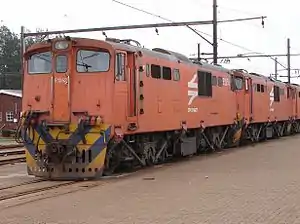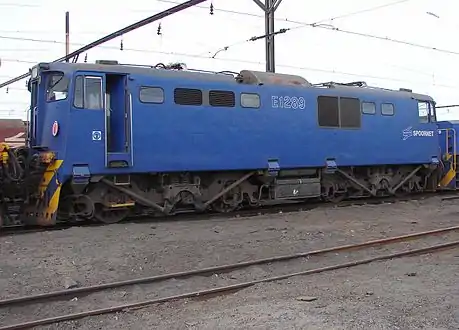South African Class 6E1, Series 2
The South African Railways Class 6E1, Series 2 of 1971 was an electric locomotive.
| South African Class 6E1, Series 2 | |||||||||||||||||||||||||||||||||||||||||||||||||||||||||||||
|---|---|---|---|---|---|---|---|---|---|---|---|---|---|---|---|---|---|---|---|---|---|---|---|---|---|---|---|---|---|---|---|---|---|---|---|---|---|---|---|---|---|---|---|---|---|---|---|---|---|---|---|---|---|---|---|---|---|---|---|---|---|
 E1252 at Sentrarand, 29 September 2009 | |||||||||||||||||||||||||||||||||||||||||||||||||||||||||||||
| |||||||||||||||||||||||||||||||||||||||||||||||||||||||||||||
| |||||||||||||||||||||||||||||||||||||||||||||||||||||||||||||
| |||||||||||||||||||||||||||||||||||||||||||||||||||||||||||||
| |||||||||||||||||||||||||||||||||||||||||||||||||||||||||||||
In 1971, the South African Railways placed fifty Class 6E1, Series 2 electric locomotives with a Bo-Bo wheel arrangement in mainline service. Series 2 was the first of the Class 6E1s to have their sandbox lids set into the bottom edge of the locomotive body sides.[1]
Manufacturer
The 3 kV DC Class 6E1, Series 2 electric locomotive was designed and built for the South African Railways (SAR) in 1971 by Union Carriage & Wagon (UCW) in Nigel, Transvaal, with the electrical equipment being supplied by General Electric Company (GEC).[2]
Fifty units were delivered in 1971, numbered in the range from E1246 to E1295. Like Series 1, Series 2 units were equipped with four AEI-283AZ axle-hung traction motors fitted with roller bearings. UCW did not allocate works numbers to the locomotives it built for the SAR and used the SAR unit numbers for their record keeping.[1]
Characteristics
Orientation
These dual cab locomotives had a roof access ladder on one side only, just to the right of the cab access door. The roof access ladder end was marked as the no. 2 end. A corridor along the centre of the unit connected the cabs which were identical apart from the fact that the handbrake was located in cab 2. A pantograph hook stick was stowed in a tube mounted below the bottom edge of the locomotive body on the roof access ladder side. The units had one square and two rectangular access panels along the lower half of the body on the roof access ladder side, and only one square access panel on the opposite side.[1]
Series identifying features



While some Class 6E1 series are visually indistinguishable from their predecessors or successors, some externally visible changes did occur over the years. Series 1 units had their sandboxes mounted on the bogies while Series 2 to 11 had their sandboxes mounted along the bottom edge of the locomotive body with the sandbox lids fitting into four cut-outs in the body on each side.[1]
The fifty Series 2 and the first fifty Series 3 units are visually indistinguishable from each other. Since the traction struts on the Class 6E1 bogie allowed room for only one footstep to be mounted on the bogie, a stirrup step was attached to the bodywork directly below the side door. On the Series 3 units in the number range from E1346 to E1445, an externally visible difference is a wider stirrup below their side doors. This appears to indicate that Series 2 should actually have consisted of one hundred units and not fifty, firstly since unit numbers E1246 to E1345 are identical in exterior appearance and secondly since Series 4, 5 and 6 were all delivered in batches of one hundred. In addition, Series 2 and 3 used the same AEI-283AZ traction motors.[1][3][4]
Service
The Class 6E1 family saw service all over both 3 kV DC mainline and branchline networks, the smaller Cape Western mainline between Cape Town and Beaufort West and the larger network which covers portions of the Northern Cape, the Free State, Natal, Gauteng, North West and Mpumalanga.[5]
Reclassification and rebuilding
Reclassification to Class 16E
.jpg.webp)
During 1990 and 1991, Spoornet semi-permanently coupled several pairs of otherwise largely unmodified Class 6E1 units, reclassified them to Class 16E and allocated a single locomotive number to each pair, with the individual units in the pairs inscribed "A" or "B". The aim was to accomplish savings on cab maintenance by coupling the locomotives at their no. 1 ends, abandoning the no. 1 end cabs in terms of maintenance and using only the no. 2 end cabs.[5]
One such pair was made up of two Series 2 units, numbers E1272 and E1273 which became Class 16E no. 16-100A and B respectively.[5]
Rebuilding to Class 18E

Beginning in 2000, Spoornet began a project to rebuild Series 2 to 11 Class 6E1 units to Class 18E, Series 1 and Series 2 at the Transnet Rail Engineering (TRE) workshops at Koedoespoort. In the process the cab at the no. 1 end was stripped of all controls to have a toilet installed, thereby forfeiting the unit's bi-directional ability. Since the driving cab's noise level had to be below 85 decibels, cab 2 was selected as the Class 18E driving cab primarily based on its lower noise level compared to cab 1, which is closer and more exposed to the compressor's noise and vibration. Another factor was the closer proximity of cab 2 to the low voltage switch panel. The fact that the handbrake was located in cab 2 was not a deciding factor, but was considered an additional benefit.[5][6]
The known Class 6E1, Series 2 locomotives which were used in this project, were all rebuilt to Class 18E, Series 2. Their numbers and renumbering details are listed in the table.[6]
Count |
6E1 no. |
Year built |
18E no. |
18E series |
Year rebuilt |
Notes |
|---|---|---|---|---|---|---|
| 1 | E1259 | 1971 | 18-426 | 2 | 2013 | PRASA |
| 2 | E1261 | 1971 | 18-824 | 2 | 2015 | |
| 3 | E1265 | 1971 | 18-752 | 2 | 2013 | |
| 4 | E1268 | 1971 | 18-751 | 2 | 2013 | |
| 5 | E1277 | 1971 | 18-801 | 2 | 2014 | c. 2014 |
Liveries
The whole series was delivered in the SAR Gulf Red livery with signal red cowcatchers, yellow whiskers and with the number plates on the sides mounted on three-stripe yellow wings. In the 1990s many of the Series 2 units began to be repainted in the Spoornet orange livery with a yellow and blue chevron pattern on the cowcatchers. In the late 1990s at least one was repainted in the Spoornet blue livery with outline numbers.[7]
Illustration
The main picture shows no. E1252 in Spoornet’s orange livery at Sentrarand locomotive depot in Gauteng.
 No. E1267 in Spoornet’s lined orange livery at Capital Park Depot, Pretoria, 10 May 2013
No. E1267 in Spoornet’s lined orange livery at Capital Park Depot, Pretoria, 10 May 2013 No. E1289 in Spoornet’s blue livery with outline numbers at Bayhead Depot, Durban, 11 August 2007
No. E1289 in Spoornet’s blue livery with outline numbers at Bayhead Depot, Durban, 11 August 2007
References
| Wikimedia Commons has media related to South African Class 6E1 Series 2. |
- South African Railways Index and Diagrams Electric and Diesel Locomotives, 610mm and 1065mm Gauges, Ref LXD 14/1/100/20, 28 January 1975, as amended
- "UCW - Electric locomotives" (PDF). The UCW Partnership. Archived from the original (PDF) on 12 October 2007. Retrieved 30 September 2010.
- E1345 with narrow stirrup
- E1346 with wide stirrup
- Railways of Southern Africa Locomotive Guide, 2002 Edition, (Compiled by John N. Middleton), p57, as amended by Combined Amendment List 4, January 2009
- Information gathered from the rebuild files of individual locomotives at Transnet Rail Engineering’s Koedoespoort shops, or obtained from John Middleton as well as several Transnet employees
- Soul of A Railway, System 7, Western Transvaal, based in Johannesburg, Part 9. South-Eastwards as far as Volksrust (2nd part) by Les Pivnic. Caption 4. (Accessed on 11 April 2017)